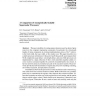Free Online Productivity Tools
i2Speak
i2Symbol
i2OCR
iTex2Img
iWeb2Print
iWeb2Shot
i2Type
iPdf2Split
iPdf2Merge
i2Bopomofo
i2Arabic
i2Style
i2Image
i2PDF
iLatex2Rtf
Sci2ools
MST
2002
2002
A Comparison of Asymptotically Scalable Superscalar Processors
The poor scalability of existing superscalar processors has been of great concern to the computer engineering community. In particular, the critical-path lengths of many components in existing implementations grow as (n2 ) where n is the fetch width, the issue width, or the window size. This paper describes two scalable processor architectures, Ultrascalar I and Ultrascalar II, and compares their VLSI complexities (gate delays, wire-length delays, and area.) Both processors are implemented by a large collection of ALUs with controllers (together called execution stations) connected together by a network of parallel-prefix tree circuits. A fat-tree network connects an interleaved cache to the execution stations. These networks provide the full functionality of superscalar processors including renaming, out-of-order execution, and speculative execution. The difference between the processors is in the mechanism used to transmit register values from one execution station to another. Both a...
| Added | 22 Dec 2010 |
| Updated | 22 Dec 2010 |
| Type | Journal |
| Year | 2002 |
| Where | MST |
| Authors | Bradley C. Kuszmaul, Dana S. Henry, Gabriel H. Loh |
Comments (0)

